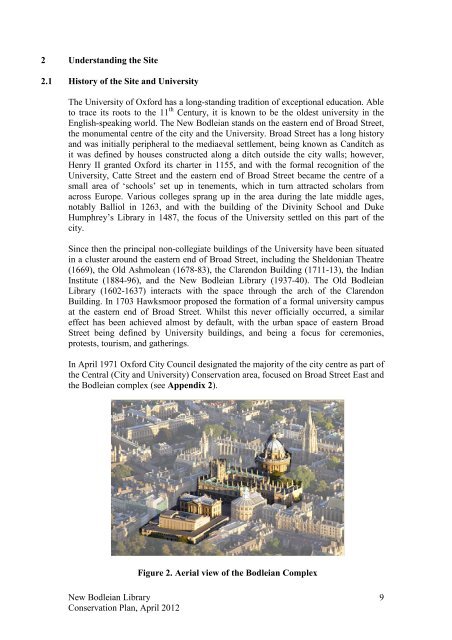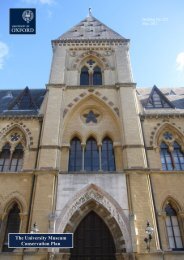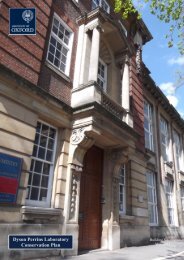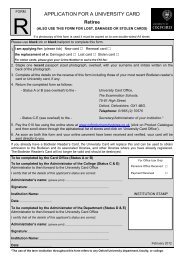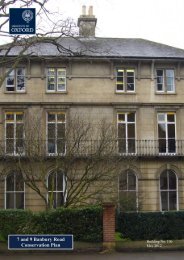The New Bodleian Library Conservation Plan - Central ...
The New Bodleian Library Conservation Plan - Central ...
The New Bodleian Library Conservation Plan - Central ...
- No tags were found...
Create successful ePaper yourself
Turn your PDF publications into a flip-book with our unique Google optimized e-Paper software.
2 Understanding the Site2.1 History of the Site and University<strong>The</strong> University of Oxford has a long-standing tradition of exceptional education. Ableto trace its roots to the 11 th Century, it is known to be the oldest university in theEnglish-speaking world. <strong>The</strong> <strong>New</strong> <strong>Bodleian</strong> stands on the eastern end of Broad Street,the monumental centre of the city and the University. Broad Street has a long historyand was initially peripheral to the mediaeval settlement, being known as Canditch asit was defined by houses constructed along a ditch outside the city walls; however,Henry II granted Oxford its charter in 1155, and with the formal recognition of theUniversity, Catte Street and the eastern end of Broad Street became the centre of asmall area of ‘schools’ set up in tenements, which in turn attracted scholars fromacross Europe. Various colleges sprang up in the area during the late middle ages,notably Balliol in 1263, and with the building of the Divinity School and DukeHumphrey’s <strong>Library</strong> in 1487, the focus of the University settled on this part of thecity.Since then the principal non-collegiate buildings of the University have been situatedin a cluster around the eastern end of Broad Street, including the Sheldonian <strong>The</strong>atre(1669), the Old Ashmolean (1678-83), the Clarendon Building (1711-13), the IndianInstitute (1884-96), and the <strong>New</strong> <strong>Bodleian</strong> <strong>Library</strong> (1937-40). <strong>The</strong> Old <strong>Bodleian</strong><strong>Library</strong> (1602-1637) interacts with the space through the arch of the ClarendonBuilding. In 1703 Hawksmoor proposed the formation of a formal university campusat the eastern end of Broad Street. Whilst this never officially occurred, a similareffect has been achieved almost by default, with the urban space of eastern BroadStreet being defined by University buildings, and being a focus for ceremonies,protests, tourism, and gatherings.In April 1971 Oxford City Council designated the majority of the city centre as part ofthe <strong>Central</strong> (City and University) <strong>Conservation</strong> area, focused on Broad Street East andthe <strong>Bodleian</strong> complex (see Appendix 2).Figure 2. Aerial view of the <strong>Bodleian</strong> Complex<strong>New</strong> <strong>Bodleian</strong> <strong>Library</strong><strong>Conservation</strong> <strong>Plan</strong>, April 20129


